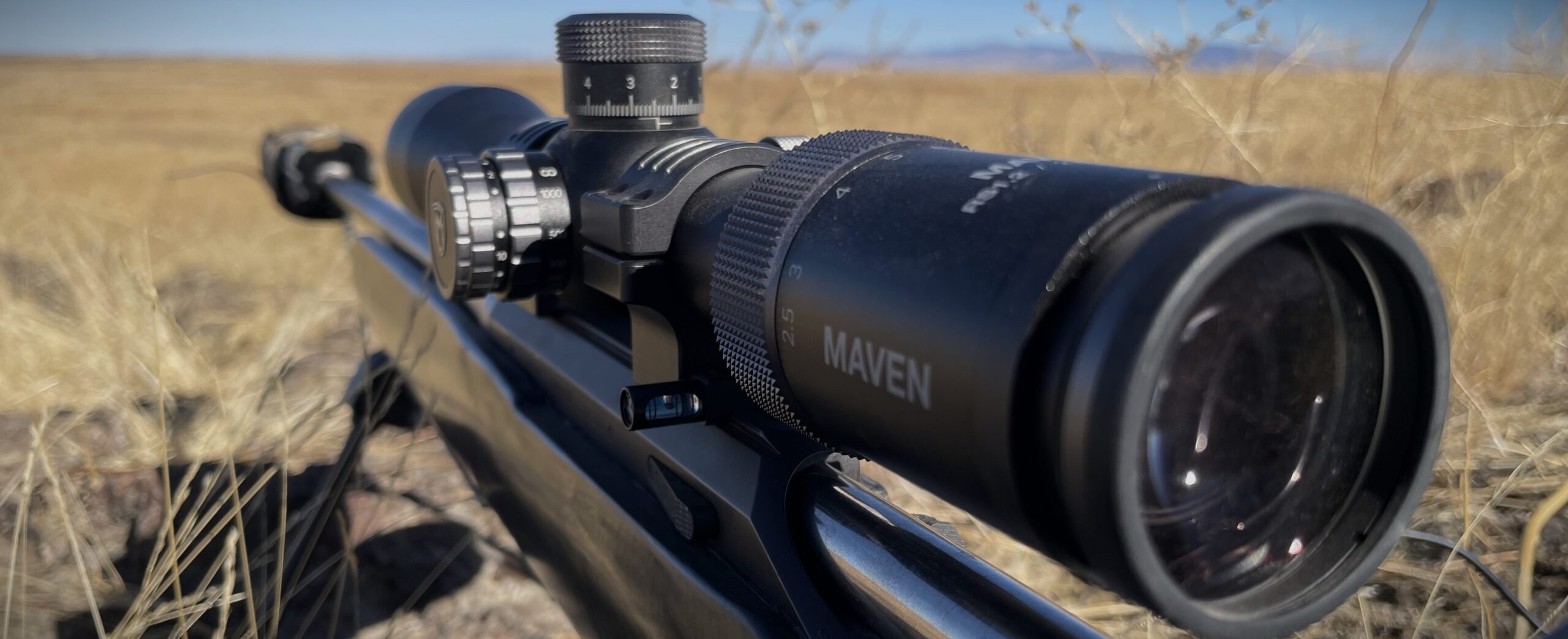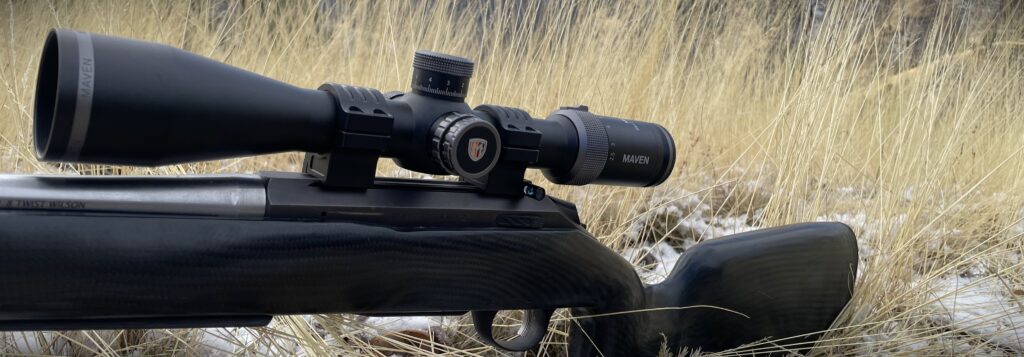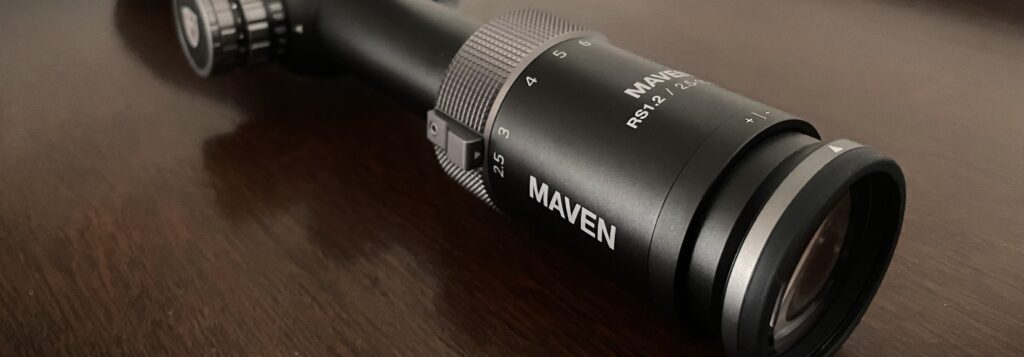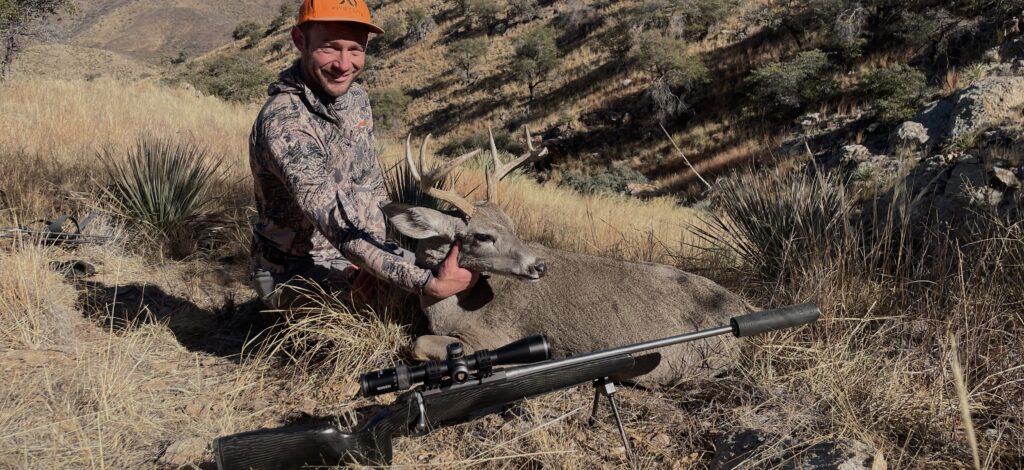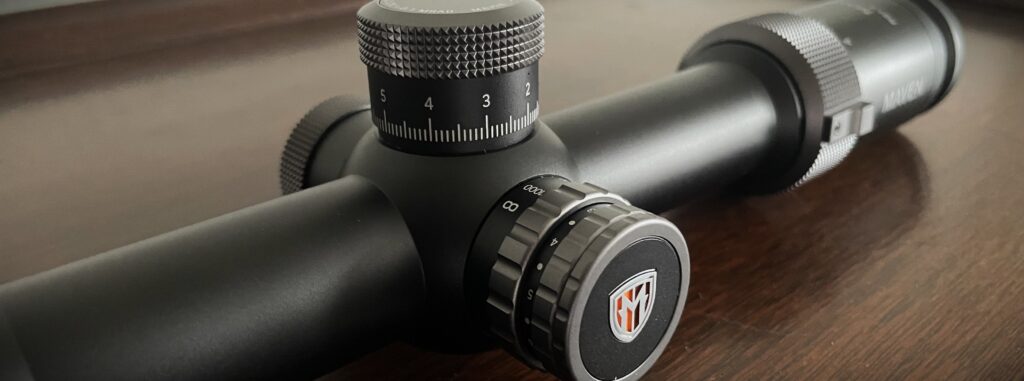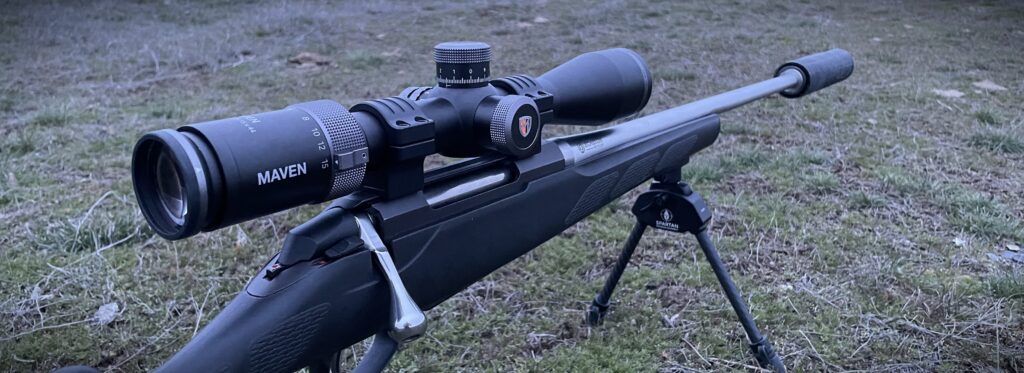The release of the Maven RS1.2 riflescope generated quite the buzz amongst western hunters in 2024. On face value, this scope appeared to be a modest update to their original RS.1, adding some helpful features like an illuminated reticle, capped windage, true zero-stop, dialable elevation turret, and a MIL version of the reticle.
While beneficial, those features are not game changers. However, their cumulative effect is substantial, and what drew a lot of attention to the Maven RS1.2 scope was it passing Rokslide’s drop testing protocol- the current DIY standard for durability. We’ll come back to what that really means, but I was excited to get my hands on this scope and put it to the test.
Deciding on a Scope – Narrowing Down the Options
Before we get too far into the details of the Maven RS1.2 riflescope, let’s take a step back. Choosing a scope is a personal decision, and no single scope is going to be the best fit for every hunter or competitive shooter. Everyone has different life circumstances, financial constraints, and likely use scenarios that are going to dictate which optic they select to top their rifle.
Here are a few critical factors to consider:
- Magnification range
- Objective size
- Weight
- Reticle design, units, and illumination
- Focal plane (first or second)
- Turret style (capped or exposed)
- Tube diameter
- Price range
There are a ton of riflescopes on the market, but if you systematically prioritize these features based on your needs, you will quickly narrow down your search to a manageable list of options.
Maven RS1.2 Specs
Now that we’ve established some of the important features in a riflescope, let’s take a look at the Maven RS1.2 specifications before diving into performance details.
| Maven RS1.2 2.5-15x44mm | |
|---|---|
| Weight | 26.4 oz |
| Length | 14.1 in |
| Objective | 44 mm |
| Zoom | 2.5x-15x |
| Eye Relief | @2.5x: 3.9 in @15x: 3.4 in |
| FOV @ 100yds | @2.5x: 41.7 ft @15x: 7 ft |
| Parallax Adjustment | 10 yds to Infinity |
| Tube Diameter | 30 mm |
| Focal Plane | First |
| Elevation Turret | Exposed, Non-Locking |
| Windage Turret | Capped |
| Elevation Adjustment | 100 MOA / 29 MIL |
| Windage Adjustment | 70 MOA / 20.3 MIL |
| Turret Travel Per Rotation | 20 MOA / 10 MIL |
| Illuminated Reticle | Yes – Multi-Stage |
| Waterproof | Yes |
| Zero Stop | Yes |
Maven RS1.2 Reticle Design
Maven was intentional about the reticles they offer in the RS1.2 riflescope. In order to satisfy a wide range of uses and preferences, the prime option for this scope is Maven’s Simple Holdover Reticle (SHR) in both minute-of-angle (MOA) and milliradian (MIL) versions. This reticle is essentially a traditional duplex that has existed for a long time featuring thicker outer posts that narrow to a finer crosshair, but the SHR also includes marked hashes, or subtensions, allowing the user to hold for elevation/windage if desired.
It also allows the user to estimate the distance to an intended target or measure the correction needed after a missed shot. Maven also offers this scope with the finer MOA-2 reticle that allows the user to simultaneously hold for elevation and wind, but my anecdotal observation is that this reticle option is more challenging to see at low magnification and has been less popular.



The original Maven RS.1 was only offered in an MOA version. After hearing from the hunting and tactical shooting community, Maven decided to also offer the RS1.2 riflescope with a MIL reticle. You may be well versed in the differences between these systems, but for those just getting started or who are unsure, both MOA and MIL are angular units of measure.
This unit of measure means that the vertical length of adjustment represented on the target increases proportionately with distance. For example, at 100 yards, one MOA is just over one inch, whereas that one MOA at 1,000 yards is approximately 10.5 inches. For that same 100 yard example, one MIL equals 3.6 inches at 100 yards and increases to 36 inches at 1,000 yards. Since MILs are a larger unit of measure, most MIL scopes (including the Maven RS1.2) offer turrets with incremental 0.1 MIL adjustments vs incremental 0.25 adjustments for MOA scopes.
Regardless, the takeaway for a hunter or a shooter is that either system is functional, has an angular basis, and your decision should be made based on what you’re comfortable with and potentially what your friends are using so that you can speak the same language.
Why I Went With MIL
I have personally always been an MOA scope shooter. They were more readily available in the hunting scopes I could afford, and the practical application of one MOA corresponding to roughly one inch at 100 yards made sense to me. However, when I acquired this scope, I elected to go with the SHR-MIL version. Part of that choice was due to my preference for the visual appearance of that reticle, and the SHR-W (MOA) version was not yet available.
The other aspect that appealed to me was a concept called “wind bracketing.” Others are more qualified to discuss this system in depth than I am, but think of it as establishing a reference wind speed for your load where your wind drift is 0.1 MIL at 100 yards and increases by 0.1 MIL for every 100 yards thereafter. If you have a 5 mile per hour (MPH) gun, then a 5 MPH perpendicular wind is going to result in 0.3 MIL of drift at 300 yards or 0.7 MIL of drift at 700 yards. The holds needed to compensate for that drift can be adjusted based on wind speed and angle.
If you’re interested in learning more, bracketing and other wind management techniques are described in greater depth here. I’m still a novice with this approach, but I’m excited to continue to improve my proficiency.
Regardless of whether you choose MIL or MOA, you can use the online Maven Ballistics Calculator to input your firearm and ammunition data (including caliber, cartridge, ballistics, Maven reticle, and environmental factors) to generate a visual output of the distances the subtensions/hashes correspond to for your gun. This is a helpful feature for those that either don’t want to dial a turret for elevation adjustments or who don’t want to rely on a ballistics calculator during the moment of truth.
Is First Focal Plane Viable for Hunting?
The Maven RS1.2 scope is a first focal plane (FFP) riflescope, which was new to me. All of my previous scopes have been second focal plane (SFP). Without getting too far in the weeds, the reticle size of a FFP scope will adjust with magnification, which enables the subtensions or hash marks to maintain a constant value throughout the magnification range.
On the other hand, the size of the reticle of a SFP scope remains constant regardless of power, but the subtension values are generally established at maximum magnification and will change through the magnification range. If I’m taking a longer shot, I’m always going to take the time to dial for elevation. However, I prefer to hold for wind, and the constant subtension values on a FFP scope allow me to determine and execute the wind hold quicker and with less opportunity for error regardless of which magnification I’ve selected for the shot.
A common knock on FFP scopes is that the reticle can be too small at low magnification or too large at high magnification to be usable. However, Maven found a great balance with the SHR-MIL reticle which I found to be very functional throughout the magnification range.
How It Was Tested – Maven RS1.2 Review
I had a new rifle built this year, which gave me a lot of range time during load development and practice sessions to get comfortable with the scope before taking it into the mountains. When fall finally hit, I had Idaho whitetail and mule deer, Idaho elk, and Arizona Coues deer hunts lined up to put this scope through the full rigors of practical field use.
Optical Performance – Maven RS1.2 Review
Maven utilized extra-low dispersion (ED) glass on this scope, and I found the image clarity to be perfectly adequate for hunting. To my eye, the glass isn’t quite as crisp as the Leupold VX-5, but that could be due to the perceived differences between a FFP and SFP scope.
I found the 2.5 to 15 magnification range to be ideal for most hunting scenarios. At 2.5x, the reticle is a little on the thin side but still functional. If I could design my perfect scope, it would probably have an upper magnification in the 18 to 20 power range, but the 15x of the Maven RS1.2 provided sufficient magnification to connect on targets as far as I attempted (around 700 yards).
Turrets / Zero Stop / Parallax / Illumination – Maven RS1.2 Review
The exposed elevation turret features crisp, tactile click adjustments and offers a true zero-stop that is easily reset. The windage turret offers the same clean adjustments but is capped to prevent unintentional shifts. The parallax knob opposite the windage turret features a smooth adjustment throughout the range and a secondary adjustment ring for the illuminated reticle.
Durability / Tracking – Maven RS1.2 Review
Durability is something I never used to consider in a riflescope. I trusted that name brand optics had proper design, assembly, and quality control procedures in place to ensure that their scopes would track and return to zero as intended. Unfortunately, as I’ve gained more experience and become more educated on the topic I have come to realize that not all scopes are created equal, and I am now unwilling to put a ton of sweat equity into a hunt only to have it spoiled by a scope failure.
My research of the Maven RS1.2 scope led me to the Rokslide drop test to see how this Maven RS1.2 fared in their infamously rigorous test which consists of a series of 18 and 36-inch drops of the rifle, followed by confirmation that the scope maintains its zero. The test also takes the turrets through their full range of adjustment multiple times to ensure that the scope returns to zero, and tracking is also evaluated.
Make sure to check out our other gear reviews and the Backwoods Pursuit YouTube Channel to help you decide what gear will help you stay out in the field longer!
Bottom line, very few riflescopes pass the Rokslide drop test. However, the Maven RS1.2 did. Already a Maven fan, this outcome caught my attention and was a primary driver for me wanting to do a review on this scope. I can also confirm that the scope held up to the abuse I threw at it, including many miles strapped to a backpack, a backcountry flight, and a several thousand mile road trip.
Even though the Maven RS1.2 passed the test noted above, I also performed my own basic box test with this Maven RS1.2 following a full season of abuse in the field to ensure that the scope tracked as intended in both horizontal and vertical dimensions, which it did with perfection. The scope also reliably returned to zero after spinning the turrets through the entirety of its 29 MILs of rotation numerous times, until I totaled over 100 MILs of adjustment, then checked its zero again. This test again confirmed the Maven RS1.2 returns to zero functionality.
What I Liked – Maven RS1.2 Review
The Maven RS1.2 checked a lot of boxes for me.
Here are some of the things I really appreciate about this scope.
- Proven durability – The Rokslide drop test is as good as it gets right now for a DIY durability test, and the Maven RS1.2 passed with flying colors. It also survived a full season of use in the backcountry and still tracked perfectly.
- Optimal magnification range for hunting
- Functional FFP reticle
- MIL and MOA reticle options
What I Disliked – Maven RS1.2 Review
I don’t have a lot to critique about the Maven RS1.2, however, if I were to get picky about a few features, here is what I would offer.
- Weight – Although the weight is reasonable, there are numerous scopes on the market such as the Vortex Razor LHT or Leupold VX-5 HD with similar specifications that weigh in between 20 and 22 ounces. I’d love to see Maven maintain durability while shedding 4-6 ounces, but that may not be a reasonable ask.
- Magnification – I’d love to see this scope offered with a maximum magnification of 18-20x.
- Reticle – Although the SHR-MIL reticle was functional throughout the magnification range (which is challenging in FFP), I found the larger 5, 7.5, and 10 mil vertical axis hash marks to unnecessarily clutter the sight picture. For my purposes, where I plan to dial for elevation, I think 5 MIL of markings along the vertical axis is adequate.
Conclusion – Maven RS1.2 Review
After a year of extensive testing with the Maven RS1.2, it has become my go-to riflescope. I am comfortable with the scope’s features and confident in its abilities. I was able to test both FFP and a MIL reticle system, and although I don’t believe either are necessary for hunting scenarios if you are confident in an alternative, they do provide some advantages like consistent subtensions and the ability to quickly apply a bracketing system to help with wind holds.
Eventually, I think someone will produce a scope as durable as the Maven RS1.2 in this magnification range that is also lighter weight, but until then, the Maven RS1.2 is a formidable option for someone that prioritizes durability.
Subscribe to Backwoods Pursuit to get Your FREE Backcountry Gear Worksheet!!!
Dial in your gear list, calculate your pack weight, and lighten up your pack with this handy tool!


